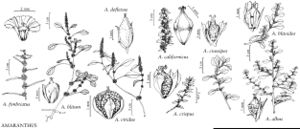Difference between revisions of "Amaranthus blitoides"
Proc. Amer. Acad. Arts 12: 273. 1877.
imported>Volume Importer |
imported>Volume Importer |
||
| Line 56: | Line 56: | ||
|publication year=1877 | |publication year=1877 | ||
|special status=Weedy;Illustrated | |special status=Weedy;Illustrated | ||
| − | |source xml=https:// | + | |source xml=https://bitbucket.org/aafc-mbb/fna-data-curation/src/2e0870ddd59836b60bcf96646a41e87ea5a5943a/coarse_grained_fna_xml/V4/V4_851.xml |
|genus=Amaranthus | |genus=Amaranthus | ||
|subgenus=Amaranthus subg. Albersia | |subgenus=Amaranthus subg. Albersia | ||
Latest revision as of 22:01, 5 November 2020
Plants annual, glabrous. Stems prostrate or ascending (very rarely suberect), much-branched (usually from base), (0.1–)0.2–0.6(–1) m. Leaves: petiole ± 1/2 as long as blade; blade obovate, elliptic, or spatulate, 1–2(–4) × 0.5–1(–1.5) cm, base cuneate and tapering, margins usually entire, plane, rarely slightly undulate, apex obtuse, rounded, mucronulate. Inflorescences axillary glomerules, green. Bracts of pistillate flowers narrow, thin, 1.5–5 mm, ± equaling or slightly exceeding tepals. Pistillate flowers: tepals (3–)4–5, narrowly ovate to broadly linear, unequal or subequal, 1.5–3 mm, thin, apex acute or acuminate; style branches spreading; stigmas 3. Staminate flowers intermixed with pistillate; tepals 3(–4); stamens 3. Utricles broadly ovoid, 1.7–2.5 mm, equaling tepals, mostly smooth (slightly verrucose or rugose in dry plants), dehiscence regularly circumscissile. Seeds black, lenticular to broadly plumply lenticular, 1.3–1.6 mm diam., rather dull.
Phenology: Flowering summer–fall.
Habitat: Disturbed habitats: roadsides, riverbanks, railroads, fields, waste places, sandy flats
Elevation: 0-2200 m
Distribution
Alta., B.C., Man., Ont., Que., Sask., Ala., Alaska, Ariz., Ark., Calif., Colo., Conn., Del., D.C., Fla., Ga., Idaho, Ill., Ind., Iowa, Kans., Ky., La., Maine, Md., Mass., Mich., Minn., Mo., Mont., Nebr., Nev., N.H., N.J., N.Mex., N.Y., N.Dak., Ohio, Okla., Oreg., Pa., R.I., S.C., S.Dak., Tenn., Tex., Utah, Vt., Va., Wash., W.Va., Wis., Wyo., introduced and often completely naturalized in South America, Eurasia, and other regions.
Discussion
The name Amaranthus graecizans often has been misapplied to both A. blitoides and A. albus in older North American floras and manuals.
Amaranthus blitoides was probably originally native to central and partly eastern United States, but now it is widely and successfully naturalized almost everywhere in temperate North America and in many subtropical to warm-temperate regions. It has not been reported from Mississippi or North Carolina but since it is found in all other conterminous United States it can be expected to occur in these two as well.
Varieties have been described within Amaranthus blitoides; most of them are of no taxonomic significance, being mostly ecologic forms or local morphologic variants. Among the infraspecific taxa, the most constant is var. reverchonii Uline & W. L. Bray, with narrower, more elongated leaves.
Selected References
None.
